Several polls, conducted recently, approve that the search engines are still regarded reliable by the internet users, yet the influence of “spammers” worries many searches.
Over 33 percent of the responders to the question: “Have Google’s Search Results Become Less Useful To You?”, said that the spammers “have gained a significant foothold”. Over 40 percent responded with the “kind of” statement, making a total of over 75% percent noticing the negative influence of “noise” on Google Search. With less than 4% stating that results got better, it seems that the spam issue needs to worry Google algorithmists.
Nevertheless, almost 90% still find Search Engines (and most use Google, of course) do either “excellent” or “good” job of finding relevant information, and about two-thirds of users rate Google results as “useful”.
With other search engines trying to close the gap between the runaway leader in the Search Industry, they might well switch their attention to inventing better search algorithms. Yet, there is no guarantee that those will produce less “noisy” results. And even if they do, and Google will lose a considerable amount of market percentage – the spammers will probably quickly adjust their techniques to alter these “new-search-algorithm” results as well…
The marketing has always been about customer’s psychology – learning the specific needs of a potential client and trying to satisfy them. Google has demonstrated once again that targeting certain audience is mandatory. And if you are into SEO, you should be aware of it.
According to one recently published study, Google Search results on a smartphone will vary by over 80% from those produced by a desktop computer query. If you think about it – this is actually quite logical to have a slightly different search algorithm for smartphones. For example, smartphone users like downloading various applications. Thus the mobile Google Search presents many results that include the word “app” or “download”. Brand filters and store filters cannot be applied to mobile Google search and it is even more biased towards “local” domains, with Google places usually appearing higher in the vertical results list.
With the smartphone market growing quickly, it seems as only a matter of time when “SEO for mobile” will become a separate branch in the industry.
Everybody knows that since the introduction of the new Caffeine index, Google is able to update its site indexing within hours and even minutes. Long gone are the days when we were shown some outdated “caption” of the website content that turned out as no longer present on the page. Different was the case with images, as Google Image Search indexing was still lagging behind. It could take a month or so for the recently added image to appear in Google Image Search results.
It appears Google, in its efforts to produce real time results, is now addressing this “problem”. Several users, who are following Google image indexing closely, have reported a major improvement in this field, stating that the new images are being indexed more fluently, appearing in Google Image Search results with a delay of several days only. This is yet another proof that non-textual content is becoming more and more popular among users, making it essential for proper SEO.
According to most encyclopedia definitions, organic searches are natural listings/results from a search-engine spider crawling a Web site. The process begins when a keyword is used in a search engine. There is no monetization (pay for these listings. It’s simply the most accurate results according to the work of the search engine. The key word here is “relevant.”
We have to accurately define “organic search results” and determine why they are important (if they still are). This will let us move on to more in-depth information about organic search results for travel. In addition, we will be able to comprehend why some observers of the Web world are writing the “obituary” for these searches on Google.
The Opposite
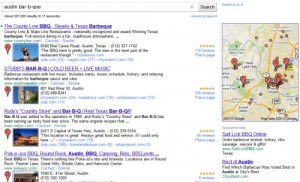 raIn recent weeks the concern has been the “death” of organic search results for travel on Google. In other words, there is concern that the majority of results for the travel industry will be paid advertising. The question is: Will you be able to come up with truly organic search results when you seek travel information?
raIn recent weeks the concern has been the “death” of organic search results for travel on Google. In other words, there is concern that the majority of results for the travel industry will be paid advertising. The question is: Will you be able to come up with truly organic search results when you seek travel information?
Processes such as pay-per-click advertising would qualify as non-organic in this discussion. Major search engines such as Google and Yahoo, for example, use combinations of advertising and search results on their pages. Ads are designed so they look like search results, though background color usually sets them apart. Many non-technical users/end users simply don’t recognize these paid listings for what they are.
Will the big spenders with Google benefit from unique technical assistance so that they achieve better “organic” search engine placement?
As We Know It
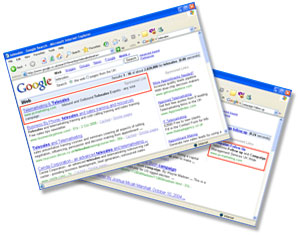 In 2010, Wired magazine carried an article that basically proclaimed the death of the Internet as we know it. The theory seems to be that we will focus on applications (apps) rather than on the search process. It seems that we are moving into a world in which final results are available, with most of the work already completed for you. This is part of the Bing story and may be a factor in the Google changes as well.
In 2010, Wired magazine carried an article that basically proclaimed the death of the Internet as we know it. The theory seems to be that we will focus on applications (apps) rather than on the search process. It seems that we are moving into a world in which final results are available, with most of the work already completed for you. This is part of the Bing story and may be a factor in the Google changes as well.
Some observers have proposed that the idea of the big-money advertisers getting the preferential placements is just good business. The big spenders have account representatives at the Google offices. Scott Buresh wrote for www.searchengineguide.com, “I am willing to bet that this perk was not Google’s idea. Rather, it almost certainly stemmed from the sense of entitlement that those spending large sums on paid search felt and the fact that technical help with their organic search engine placement is what they demanded.”
He asks whether Google can continue to work with its “Don’t Be Evil” philosophy. Will this be replaced by a philosophy that focuses on keeping shareholders happy?
Upgrades and Improvements?
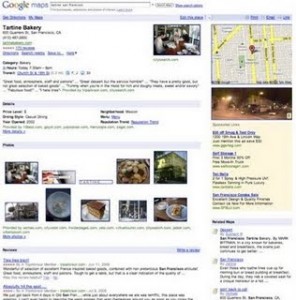 The concern about the death of organic search results for travel grew from an announcement by Google about upgrades to the search process. When search results are displayed the user will see a much different design. Two major items that will be obvious to regular users will be maps on the right side of the screen and additional content that is not actually part of results listings.
The concern about the death of organic search results for travel grew from an announcement by Google about upgrades to the search process. When search results are displayed the user will see a much different design. Two major items that will be obvious to regular users will be maps on the right side of the screen and additional content that is not actually part of results listings.
The problem seems to be that this will create confusion rather than being an improvement. In some cases the organic search results that most Google users are familiar with end up with borders that set them off, though this section doesn’t have the colored background that paid listings have.
Another user, from another part of the world, gets similar results but the organic results are not set off by a border and appear as they generally do with organic searches. Google has already written about this change and insists that what they call Universal Search results are definitely organic, not paid for or click-based.
Kevin May wrote, on www.tnooz.com, that an experienced analyst for a digital-marketing agency expressed concerns about the design.
“This forces brands to consider Google as a content destination as well as a search provider. Google Places may well be significant in this. It’s not surprising Google is doing this, it’s long been predicted Google would expand Universal Search into a polymorphic vertical search.”
Content Destination
For some who have long supported the openness and freedom of the Internet and the World Wide Web the idea of the major search engine morphing into a content destination is troublesome, at best. Of course, Google has expanded and changed through the years, offering products and services that many find useful, even essential, in the online world.
It seems that some users are beginning to question why Google can’t keep its search-engine service separate from its revenue stream. While this hasn’t been the case for years, it might seem that the limited paid-for results of the past are becoming just that – a thing of the past.
We all know that page design is one of at least three major factors in successful online marketing. Design works hand-in-hand with quality content and a call to action. If Google search results are becoming content destinations, at least in the travel arena, how long will it be before there is an overt call to action for the biggest advertisers?
In the opinion of some long-standing Web watchers, the design, placement and percentage of page coverage devoted to larger revenue streams is already a covert call to action. If the search results for travel are no longer truly organic can other commercial sectors be far behind?
The bottom line is, if a Web site has a good quantity of reliable, subject-related links it should be placed at or near the top of the popular search engines. Link building is both a science and an art. There are proven ways to make these connections work without wasting a lot of time and money getting onto every list available. This means you have to do what it takes to make your site and your links available to the correct group of people.
 The network that can carry a Web site to the top is built with exposure to a specific group of people. Target audiences are the crucial factor for anyone considering directory submissions.
The network that can carry a Web site to the top is built with exposure to a specific group of people. Target audiences are the crucial factor for anyone considering directory submissions.
Assume you have a site that offers Product X and related services. A particular sector of the online population will go to search engines and use Product X or one of the related services as a keyword for their search. Your goal is to have a Web site and its link at the top of the search engine when this target group searches. This could mean significant traffic to your site and consequently, significant income for you.
Link building is not a quick way to make a dollar or two. It takes careful planning and serious effort. You should also make use of several of the quality directories in your chosen area, whether these are link directories, article directories or a combination of both. You should also know about the different kinds of links so you can make the most efficient use of your time and effort.
Here are some key categories:
This is only a short list!! There are many other types of links that you can use to build your presence. Use these ideas and learn more about: site-wide links; three-way link; links to and from media outlets such as radio stations, television stations and newspaper companies; edu and gov links; article submission links.
Not Just the Traffic, Silly!
 No matter how you go about getting linked up with others who have similar interests, stimulating traffic is only part of the story. Remember, we mentioned conversations earlier. Success in the online world is about connections, of course, but after you make the connection you need to continue the conversation.
No matter how you go about getting linked up with others who have similar interests, stimulating traffic is only part of the story. Remember, we mentioned conversations earlier. Success in the online world is about connections, of course, but after you make the connection you need to continue the conversation.
Of course, it’s tempting to just get started, try to make money quickly and move on to something else. A few people have been fortunate enough to do this. You may find that success has a short life span when you flood the Web with information and hope 1 percent or 2 percent come back to you. However, if you have a little more patience than the next guy, use some intelligence and focus on the right link or article directories you may find yourself building a more long-term business.
You may as well begin with the free directories when you begin the process of submitting your site link to a links directory. Many of these will establish good connections in sufficient numbers. It pays, however, to be selective when submitting to the many free directory sites. You could sign on with a link-submission service if you have funds to pay the fees. Be very selective with this method because some services might flood the Web with your link and you are looking for quality connections.
People interested in your particular service or product will be looking for your sign and a brief explanation of what you offer. Those who are searching for something entirely different probably won’t come into your “store.” Your choice of a few select link or article directories is like putting up the right sign on your “main street business.” In fact, it may be better if they don’t. You need to focus on the customers with real potential.
One of the key factors in business success is leverage. Microsoft Advertising Intelligence allows you to leverage true history and forecast data. This means your keyword efforts are based on actual customer activity. You get key performance indicators (KPI) to track performance.
The full name of this tool is Microsoft Advertising Intelligence. It is designed as a research and optimization tool that works with Microsoft Office Excel 2007, providing keyword expansion, pricing, KPI data and research. What this means for the business person is that you can make the most of your marketing investment. You’ll need to uninstall the earlier versions of adCenter Add-in for Excel. Of course, you should have Microsoft Office Excel 2007 installed. Be sure Excel is closed when you go through the Ad Intelligence install process.
With Ad Intelligence you can work with lists of suggested keywords, and develop your strategy for keywords using MSN and Bing query information. The details include volume, relevance, demographic and geographic tracking as well as cost history. This data helps you fine tune your bid strategy because you use actual pricing information and data that is specific to keywords. You get information on clicks, impressions, cost-per-click and position.
As product information for Ad Intelligence states, “Search activity reflects real time consumer behavior which helps determine the best planning approach for your online and offline campaigns. This ensures you are talking to your consumers with the right message, at the right time in the right place, to build truly integrated campaigns.”
Planning for Success
It’s tempting to get into the online marketing business because it seems the “hot” thing to do. But if you want to increase the chances of success you should devote some time to planning first. Microsoft Advertising Intelligence is designed to assist you in that planning process. For example, your working campaigns will be constructed on reliable information, data that allows you to make good decisions.
Ad Intelligence means using keyword search tools built into the Excel program as well as developing keyword lists based on actual behavior and trends. Data you can use includes relevant rankings that will help you understand how this will add value to the effort. You will be able to use your business budget on campaigns that actually work!
Features that will help your efforts succeed include a keyword wizard that lets you pull keywords out of an Excel list or from a specific URL. You can then expand your keyword list based on bidding association, similarity of categories or keyword phrases that contain the single keyword. You can move a detailed report containing estimated search volume, ad position, click-through, click cost for a specific range of dates etc.
Search buzz focuses on top-category keywords, with almost two dozen core categories available. There are dozens upon dozens of subcategories. If you are familiar with the usefulness of “spiky” numbers you’ll find that Ad Intelligence uses the above-mentioned categories but focuses on spiky keywords. Features include spike start and end dates as well as spiky index. One of the key features allows you to set your information to all verticals so you can uncover the leading spiky keywords or top search queries.
There’s More!
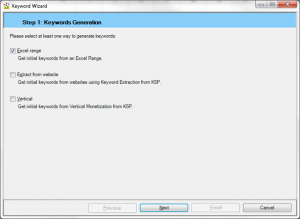 Microsoft Advertising Intelligence offers keyword-focused tools such as extraction that is based on input URL. You will be able to set the maximum number of keywords up to 100. It even allows you to establish a minimum relevancy so you can tailor your confidence level. If you are not sure of the efficiency of a certain keyword the tool has keyword suggestion to help you. Suggestions are based on such details as long-tail keywords containing the core keyword and on advertiser behavior.
Microsoft Advertising Intelligence offers keyword-focused tools such as extraction that is based on input URL. You will be able to set the maximum number of keywords up to 100. It even allows you to establish a minimum relevancy so you can tailor your confidence level. If you are not sure of the efficiency of a certain keyword the tool has keyword suggestion to help you. Suggestions are based on such details as long-tail keywords containing the core keyword and on advertiser behavior.
Other features include:
One of the nice tools available in Ad Intelligence is keyword normalization. This means that the software will find and flag duplicates in an advertising group. The feature might select a keyword if it has extraneous characters or if capitalization is a bit different. This process takes place automatically and will save the use a lot of time. You don’t have to manually manage variations of the same keyword.
Extraneous characters might be quotation marks, hyphens, asterisks, parentheses, brackets and many other common symbols. Extraneous words such as “a” and “an” may trigger normalization as well.
The advertiser can remove duplicates or remove the original. With the automatic task in Ad Intelligence and some careful editing by the advertiser this feature will mean more search queries match chosen keywords. Advertising return should be increased with this fine-tuning process.
This group of tools is designed to help advertisers improve their online advertising results through accurate modeling. Business owners will be able to more correctly predict intent of the user because of the specific data based on keyword and phrase selection. This can be an awesome tool in the online commercial world. Why? Because the way people search is determined by geography, demographics, age, gender and other factors.
Keyword and search characteristics provide a nice overview of the target audience. An advertiser use Ad Intelligence is able to learn more about a user’s intent and discover a doorway into a social network that this user is part of.

The fundamentals of SEO apply regardless of which search engine you want to rank in, but each of the major ones has some finer points, so let’s get right to them.
You may have heard that participating in Google AdWords would penalize your site in other search engines, but Yahoo! insists that this is not the case. They really have nothing to gain by dropping sites that are relevant, and if they did, they’d be cutting off their nose to spite their face. But the age of your domain is important because a longer track record ups a site’s relevancy. It’s only one score, and it’s one you can’t do much about, but it’s something to keep in mind: SEO is a long term idea.
Yahoo! suggests registering domains for more than one year at a time. It gives your site a long-term focus and keeps you from accidentally losing a domain because you didn’t find the email that it was time to renew. They also suggest you should buy the same domain name with and without dashes. This will keep you from losing so-called type-in traffic. However, all SEO pundits say that the more dashes, the harder it is to type in, and the more spam-like it will look, so don’t get carried away.
Like with Google, with Yahoo!, relevant inbound links from high quality pages are gold. This is one of the hardest parts of SEO, but it’s one where there really aren’t many shortcuts. You want links from sites that belong to the same general neighborhood of topics as yours. If you have a site that sells organic flour, a link from a fishing tackle site isn’t going to help you much, if at all. And when it comes to giving out your own links, be careful here as well. If you link to a lot of sites that are or could be penalized, you could be hurting yourself by association. If you sell text links, check out every site that buys from you to make sure you’re not endorsing spam, porn, or other content that search engines frown upon.
Make use of Yahoo Site Explorer to see how many pages are indexed and to track the inbound links to your site. The first screen shot shows the results of the analysis of one site. As you can see, there are 503 pages on the site, and 5,838 inlinks, each of which you can explore further. To maximize crawling of your site and indexing of pages, publishing fresh, high quality content is the key.
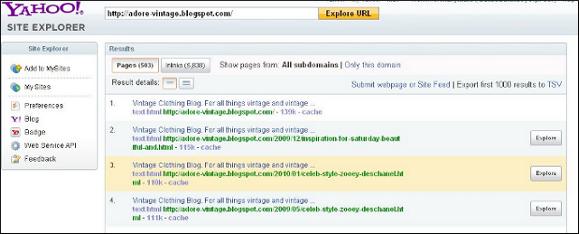
There have been some case studies about what Bing looks at compared to Yahoo! and Google when ranking sites. When ranking for a keyword phrase, both Bing and Google look at the title tag 100% of the time. Prominence is given a little more weight with Bing than with Google, while Google favors link density and link prominence more than Bing. Bing evaluates H1 tags, while Google does not, and Google considers meta keywords and description while Bing does not. What that all boils down to with Bing is that having an older domain and having inbound links from sites that include the primary keyword in their title tags (another way of saying relevant inbound links) are keys to optimizing for Bing. Like optimizing for the other major search engines, link building should be a regular, steady part of your SEO effort.
With Bing, it’s easier to compete for broad terms. With Bing, keyword searches result in Quick Tabs that offer variations on the parent keyword. This has the effect of bringing to the surface websites that rank for those keyword combinations. The goal is for content-rich sites to convert better than sites with less relevant content. The multi-threaded SERP design brings up more pages associated with the primary keywords than would come up with a single-thread SERP list. Also, Bing takes away duplicate results from categorized result lists. This allows lower ranked pages to be shown in the categorized results.
The Bing screen shot shows the results for a search on “video cameras.” To the left is a column of subcategories. Results from those subcategories are listed below the main search results. While there are some differences to SEO for Bing, the relatively new search engine isn’t a game changer when it comes to SEO.
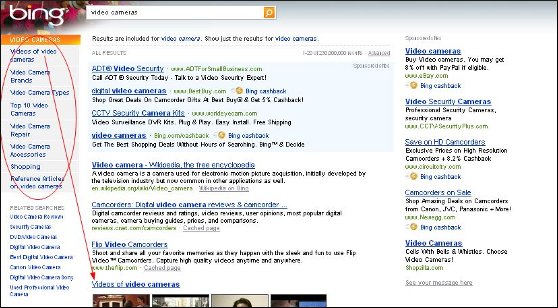
It sometimes seems as if SEO is synonymous with “SEO for Google,” since Google is the top search engine. And it also seems that when it comes to SEO for Google, a lot of the conventional wisdom has to do with not displeasing the Google search engine gods by doing things like cloaking, buying links, etc.
The positive steps toward SEO with Google include keywords in content and in tags, good inbound links, good outbound links (to a lesser extent), site age, and top level domain (with .gov, .edu, and .org getting the most props). Negative factors included all-image or Flash content, affiliate sites with little content, keyword stuffing, and stealing content from other sites. It isn’t so much that Google wants to seek out an destroy sites that buy links, but they want the sites with actual relevant, fresh content to have a shot at the top, and with some sites trying to game the system and get there dishonestly, Google has to find a way to deal with these sites without hurting the good sites.
In fact, Google wants users to report sites that are trying to cheat to get to the top of the search engines. On the screen shot, you can see a copy of the form found at https://www.google.com/webmasters/tools/spamreport?pli=1 for reporting deceptive practices. You have to be signed in to your Google account to use this, by the way. They want to get away from anonymous spam reports.

It seems we’re always hammering home the importance of link building, external links, and inbound links, and that sometimes makes us minimize the importance of the links available right there on your own pages. After all, you have complete control over the pages on your site, and if they have matured to where they have page rank, then that’s even better. There’s a lot you can do with respect to how your pages pass rank, which influences how search engines view the content on your pages.
SEO and high ranking for competitive terms actually has a lot to do with your internal link structure, though you might never know it for the choruses of “link building or die!” (which, yes, we’ve been guilty of as well). A new site that’s designed well, that’s themed and structured topically around a specific handful of keywords, has a better chance of rising to the top of the SERPs than an older site that doesn’t take this structure into account with respect to internal links, content, and naming conventions of filenames.
Since you have control over your internal pages, you might as well make the most of your on-site SEO opportunities. There’s a lot you can do to increase the relevance of all the pages on your site.

 Start by making all your links absolute and getting rid of any secondary keywords that are irrelevant. As your pages mature, you want to make sure that they have names in the format of http://www.yourwebsite.com/pagename.html. That causes your pages to boost each other in the SERPs, and ensures that if your content is copied, the links will point back to your pages, giving you another back link (hooray!).
Start by making all your links absolute and getting rid of any secondary keywords that are irrelevant. As your pages mature, you want to make sure that they have names in the format of http://www.yourwebsite.com/pagename.html. That causes your pages to boost each other in the SERPs, and ensures that if your content is copied, the links will point back to your pages, giving you another back link (hooray!).
Put a limit on your outbound links at about 10. This helps you keep your pages focused. The fewer the outbound links, the more link juice the page has to transmit to its own keywords. This should be come evident when you start building external links and see how quickly the pages float to the top of the SERPs.
Optimize your anchor text by making sure your main keyword phrase shows up at least once on the page and in the title. If you assign each link wisely, you can nail down a handful of keywords that you want to show up exactly when people do searches. But don’t optimize any given page for more than three keywords. And if your page is getting much over 750 words, try to changing it into two pages with another keyword variation. This can get you double listed in the SERPs.
Keep in mind that contextual links inside your content should go high up on the page – above the fold if possible. Links that show up higher on the page carry more influence in search engines when compared with footer links. And if you’re using contextual links within your site, make sure you use the main keywords for the page that you want to rank with. In other words, make sure the anchor text on page x uses the keywords for page y that you want to rank for. This improves the quality of the internal back link with time, and in the meantime keeps your relevance high.
It’s ideal if you keep your Javascript and other programming code off the page in its own file, hyperlinked to the page. Cascading style sheets are the best because they separate content from images ind give the search engines what they’re hungry for without a bunch of excess. And, of course make sure your pages are laser focused. The main keyword should appear two to four times on the page, once in the h1 tag, with a variation on the keyword in the h2 tag.
 It’s also important to remember that keyword stuffing isn’t good. It’s one of those cases where less is more. Keep it to the basics of once in the title, again in the description, and a few times on the page. And once in your h1 tags.
It’s also important to remember that keyword stuffing isn’t good. It’s one of those cases where less is more. Keep it to the basics of once in the title, again in the description, and a few times on the page. And once in your h1 tags.
You know how when you break a toe, the doctor will often “buddy tape” the broken toe to its neighbor to provide support as it heals? Well, You can buddy tape your pages by letting four or five of your highest ranking pages concentrate their link-mojo to your newest page, the one that may be slightly wobbly and needs to build up its strength. This is a good idea whenever you launch a new page.
Sometimes you need to do some housecleaning as well. Getting rid of off-topic pages and doing a 301 redirect to another page (or your home page) that’s been indexed. Some people will buy a new domain name made up mostly of your keywords, then redirect your old site to the new one. This is a little controversial, and can be painful in the short term, because it will take a few weeks for your rankings to get back up to where they were. However, the rankings should come back stronger in the long run, assuming you’ve done your due diligence with optimizing.
This is a sort of risky move, and if you’re put off by the idea, you could instead make sure you have a blog that’s listed in blog directories and start updating it regularly to increase how often the blog is crawled. This should eventually lift the tide for your whole site from all the spidering going on.
If you take care of these on-page optimization techniques, then think how powerful your off-page optimization will be!

Online public relations campaigns can be used as very effective off-page SEO. Done well, they can increase targeted traffic to your site. A good PR effort for SEO should include keyword optimized press releases to increase the visibility of your brand in the marketplace and get you more leads and sales.
In the best of all worlds, you would use both “push” and “pull” marketing, where you push your message to the media your prospects tend to use most. The pull strategy “pulls” prospects to your site by making your site more visible in media where your prospects already visit. The end result can be more traffic, higher placement on SERPs, more organic, high quality, inbound links to your site, and press releases being picked up by top industry publications.

The question isn’t so much can you get a decent SEO education for free, online, but will you get a decent SEO education for free, online? There’s a fascinating story in the April 2010 issue of Vanity Fair about a 32-year-old investor who learned how to trade credit default swaps as the real estate bubble inflated and got out right before it burst. How did he do it? Basically, he got his hands on all the information out there, namely the prospectuses that investment companies pump out every quarter, and actually read them. By taking the time to learn the definitions, the risks, and the market cues, he made a fortune. Though you might not make a fortune, there’s just as good a case for availing yourself to all the readily available SEO information out there. You can always sign up for paid classes later. Here’s a sampling of what’s out there.
 Searchengineland.com makes a strong case for in-house SEO education for every sector of website production and maintenance. Effective website design is the rock bottom basic of good SEO. Your website designers should learn how good design influences SEO, your content writers should learn how good content with appropriate keyword use and anchor text influences SEO, and your IT gurus need to know how to do migration and development tasks without compromising the site’s SERP ranking. Programmers and coders should be well-versed in canonicalization and other code-related SEO issues, and marketing staff should learn the importance of good, relevant back links to your website. The philosophy is a “no colleague left behind” approach to SEO. Sharing of SEO wisdom among staff of every stripe is encouraged, as is an internal blog outfitted with SEO references and keyword lists. All staffers need to know what the bottom line results are, such as “Last month we saw an 80% increase in traffic to this page, which translated into $10,000 in revenue.”
Searchengineland.com makes a strong case for in-house SEO education for every sector of website production and maintenance. Effective website design is the rock bottom basic of good SEO. Your website designers should learn how good design influences SEO, your content writers should learn how good content with appropriate keyword use and anchor text influences SEO, and your IT gurus need to know how to do migration and development tasks without compromising the site’s SERP ranking. Programmers and coders should be well-versed in canonicalization and other code-related SEO issues, and marketing staff should learn the importance of good, relevant back links to your website. The philosophy is a “no colleague left behind” approach to SEO. Sharing of SEO wisdom among staff of every stripe is encouraged, as is an internal blog outfitted with SEO references and keyword lists. All staffers need to know what the bottom line results are, such as “Last month we saw an 80% increase in traffic to this page, which translated into $10,000 in revenue.”
2. SEOmoz.org
SEOmoz.org is great for stepping SEO beginners through the process of optimization with handy checklists and other articles. One very helpful article is a sort of master checklist for learning SEO. You get lots of information on the basics: how to design a search engine-friendly site, how to find good html and CSS tutorials, how to choose the best keywords (hint: it involves “Googling” your brand), and how to find good website hosting. SEOmoz highly recommends using the free tools offered by Google since, after all, they’re the top search engine, and they have tools like a rank tracker to help you make the most accurate possible assessment of where your site ranks and why. SEOmoz also points out that with SEO there is a certain amount of hurrying up and waiting, since the big engines index sites on their own timetables rather than yours. There are enough free tools and tutorials to keep an eager SEO student busy for a long time.
3. SEObook.com
 A free account on SEObook.com gets you plenty of training tools and access to very valuable forums on SEO in the trenches. There are paid accounts too, that let you access even more training, but you can go along for a good while learning from the free tutorials and articles available. The screen shot shows one such page, on learning to track results so you can figure out what is going right and what is not. Some of the modules are free, and some only come with paid memberships, but you can learn an awful lot by exhausting the free tools and tutorials first. SEObook takes a “snowflake” approach to SEO, based on no two business or websites being alike. The site is limited to 1,000 members so that everyone has a chance to be heard and partake of all the information on offer.
A free account on SEObook.com gets you plenty of training tools and access to very valuable forums on SEO in the trenches. There are paid accounts too, that let you access even more training, but you can go along for a good while learning from the free tutorials and articles available. The screen shot shows one such page, on learning to track results so you can figure out what is going right and what is not. Some of the modules are free, and some only come with paid memberships, but you can learn an awful lot by exhausting the free tools and tutorials first. SEObook takes a “snowflake” approach to SEO, based on no two business or websites being alike. The site is limited to 1,000 members so that everyone has a chance to be heard and partake of all the information on offer.